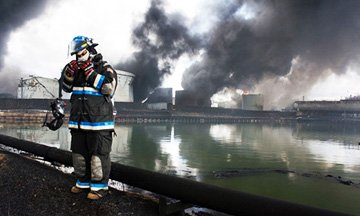Injury and Illness Prevention Program (IIPP) Training
Course Overview
The Injury and Illness Prevention Program (IIPP) describes specific requirements for program accountability, conformity, communications, hazard evaluation, accident inquiries, hazard correction, training, and documentation.
Ever since the Occupational Safety and Health (OSH) Act was signed, workplace deaths and reported occupational damages have dropped by over 60 %. This program’s purpose is to help employees understand the core principles of HSE and avoid on-the-job risks.
How does this “Injury and Illness Prevention Program (IIPP) Training Course” guide organisations to prevent injuries? Every organisation is different, so when it comes to injury prevention programs, one size may not necessarily fit all.
In terms of HSE, there are some core elements in the organisational plan that are important to ensure the success of the program, and these elements are interconnected. These elements consist of worker participation, management leadership, hazard identification and assessment, hazard prevention and control, education and training, program evaluation, and continuous improvement.
Companies who implement the IIPP mould these elements to meet the needs of their organisations, depending on size, industry, and operational complexity.
This Zoe training course will empower you with the knowledge to comply with the requirements of HSE and know where to go with questions, concerns, and ideas on safety and health issues.
Course Objectives
Upon completing this Injury and Illness Prevention Program (IIPP) Training Course successfully, participants will be able to:
- Identify the IIPP injury and illness prevention requirements
- Describe the significance of an Injury and Illness Prevention Program (IIPP) in preventing injuries and illnesses
- Learn the various elements of a successful IIPP
- Discover how to investigate work-related accidents and injuries
- Develop compliance strategies
- Maintain documentation for health and safety programs
- Work collaboratively with other participants to design workplace hazard protocols
- Improve your overall personal safety and health at the workplace
Training Methodology
This collaborative Injury and Illness Prevention Program (IIPP) Training Course will comprise the following training methods:
- Lectures
- Seminars & Presentations
- Group Discussions
- Assignments
- Case Studies & Functional Exercises
Just Like all our courses, this training program also follows the ‘Do-Review-Learn-Apply’ model.
Organisational Benefits
Companies who nominate their employees to participate in this Injury and Illness Prevention Program (IIPP) Training Course can benefit in the following ways:
- Attain improved workplace safety and health, better morale, increased productivity, and reduced costs of doing business
- Assess your workplace IIPP by evaluating its effectiveness to reduce injuries and illnesses and identifying and eliminating workplace hazards
- Put employees with IIPP responsibilities closer to compliance tasks and effective application resulting in fewer incidents, decreased costs, and improved employee morale
- Avoid the considerable cost impressions and business interruptions that come with occupational injuries, illnesses, and deaths
- When employees know you care about their well-being, it increases morale, engagement, awareness, motivation, and productivity
- Apply a meticulous and methodical review process to depict and evaluate the successes and lessons learned from existing HSE systems
Personal Benefits
Individuals who participate in this Injury and Illness Prevention Program (IIPP) Training Course can gain from it in the following ways:
- Improve your performance through higher efficiency and greater worker productivity by being aware of HSE-related risks
- Participate in conversations with management and each other about safety and health, leading to improved corporate relationships and better overall communication
- Prevent personal injuries by following stipulated safety guidelines and best practices
- Aid your company by preventing medical and legal expenses arising from HSE violations or accidents
- Share worldwide knowledge on leading-edge HSE management systems and best practices for educational purposes
- Support your teams and departments in designing and maintaining safe work practices
Who Should Attend?
This Injury and Illness Prevention Program (IIPP) Training Course would be suitable for:
- Industrial Hygienists
- Safety Engineers
- Health and Safety Professionals
- Union Representatives
- Risk Managers
- Loss Control Specialists
- Management Health and Safety Committee Members
- Supervisors
- All employees with HSE responsibilities
Course Outline
MODULE 1: INCIDENT INVESTIGATION: THE BASICS
- Why call the situation an incident instead of an “accident”?
- Incident types
- Why do we conduct an Incident Investigation?
- Incident Investigation Programs that work
- When OSHA conducts Incident Investigation:
- Case scenarios
- The fines
- Avoiding citations, penalties, and fines
MODULE 2: WHY DO BAD THINGS HAPPEN TO GOOD EMPLOYERS?
- Initiating the investigation
- Securing the scene
- When to start your incident investigation
- Reporting Incident to OSHA
- Reporting vs Recording
- What should I report?
MODULE 3: METHODS OF DOCUMENTING THE INCIDENT SCENE
- Personal observations
- Getting initial statements and taking pictures
- Taking videos and sketching a scene
- Interviewing our records
MODULE 4: CONDUCTING EFFECTIVE INTERVIEWS
- The interview processes
- Preparing for the interview
- Who should be interviewed?
- Bad interview vs. Good interview
MODULE 5: CONDUCTING EVENT ANALYSIS
- Surface cause vs Root cause
- Employing the “Multiple Event” theory to avoid future incidents
- Developing the sequence of events
- Sample sequence of events
MODULE 6: ROOT CAUSE ANALYSIS
- Difference between the surface and root causes
- Describing direct causes
- Sample tools for Root Cause Analysis
- System analysis
MODULE 7: DEVELOPING SOLUTIONS AND RECOMMENDATIONS
- How to get upper management’s support?
- OSHA’s hierarchy of controls
- Recommending system improvements
- The “6 Question” approach for designing solutions and recommendations
- The direct and indirect cost of incidents
- Safety pays
MODULE 8: WRITING THE INCIDENT REPORT
- Who is your audience?
- Roles and responsibilities
- Order and sections of the incident report
- Important sections of the incident report
MODULE 9: PRACTICAL APPLICATION
- Case scenarios
- Role-playing activities
MODULE 10: THE EIGHT CORE ELEMENTS OF IIPP
- Responsibility
- Compliance
- Communication
- Hazard Assessment
- Accident Investigation
- Hazard Correction
- Training and Instruction
- Record-keeping
MODULE 11: COSTS OF WORKPLACE INJURIES
- Physical, financial, and emotional hardship
- Workers’ compensation benefits
- Medical insurance
- Loss of employment and wages
- Burdensome debt
- Incapability to satisfy the cost of living
- Loss of homeownership
- Bankruptcy
- Wages paid to injured workers for absences
- Wage costs related to a work stoppage
- Administrative time spent by supervisors following injuries
- Employee training and replacement costs
- Lost productivity due to new employee learning curves
- Accommodation of injured employees
- Replacement costs of impaired material, equipment, or premises











